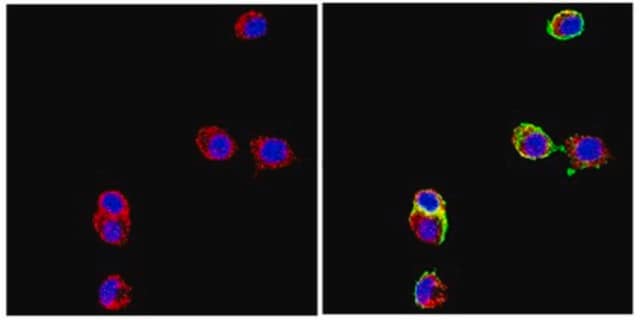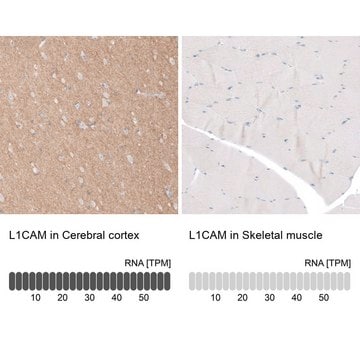L4543
Anti-L1CAM antibody, Mouse monoclonal
clone UJ127.11, purified from hybridoma cell culture
Synonym(s):
L1CAM Antibody - Anti-L1CAM antibody, Mouse monoclonal, L1Cam Antibody, Anti-CAML1, Anti-L1 Cell Adhesion Molecule, Anti-MIC5, Anti-Neural Cell Adhesion Molecule L1
About This Item
Recommended Products
biological source
mouse
Quality Level
conjugate
unconjugated
antibody form
purified immunoglobulin
antibody product type
primary antibodies
clone
UJ127.11, monoclonal
form
buffered aqueous solution
mol wt
antigen 220-240 kDa
species reactivity
human
packaging
antibody small pack of 25 μL
concentration
~2 mg/mL
technique(s)
flow cytometry: suitable
immunocytochemistry: suitable
immunohistochemistry: suitable
immunoprecipitation (IP): suitable
microarray: suitable
western blot: 0.25-0.5 μg/mL using cell extracts of G361 cells (human melanoma)
isotype
IgG1
UniProt accession no.
shipped in
dry ice
storage temp.
−20°C
target post-translational modification
unmodified
Gene Information
human ... L1CAM(3897)
Related Categories
General description
Immunogen
Application
- immunohistochemistry
- immunoprecipitation
- immunoblotting
- immunocytochemistry
- flow cytometry
Immunohistochemistry (1 paper)
Western Blotting (1 paper)
Biochem/physiol Actions
Physical form
Disclaimer
Not finding the right product?
Try our Product Selector Tool.
Storage Class Code
10 - Combustible liquids
WGK
WGK 3
Flash Point(F)
Not applicable
Flash Point(C)
Not applicable
Certificates of Analysis (COA)
Search for Certificates of Analysis (COA) by entering the products Lot/Batch Number. Lot and Batch Numbers can be found on a product’s label following the words ‘Lot’ or ‘Batch’.
Already Own This Product?
Find documentation for the products that you have recently purchased in the Document Library.
Customers Also Viewed
Our team of scientists has experience in all areas of research including Life Science, Material Science, Chemical Synthesis, Chromatography, Analytical and many others.
Contact Technical Service











